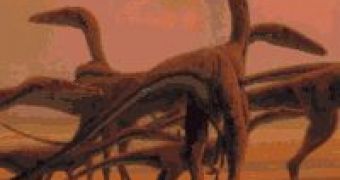In 1947, in Ghost Ranch, north of Santa Fe (New Mexico) were found hundreds of fossils of Coelophysis ("hollow form" in Old Greek, because of its hollow bones), apparent victims of some type of mass mortality.
Two individuals seemed to have in the guts remains of young individuals of the same species. The skeletons were too far developed to be unborn fetuses, so the late Edwin H. Colbert, chair of the department of vertebrate paleontology at American Museum of Natural History concluded the remains were the last meals of larger individuals -and dramatic evidence of an appetite for their own offspring.
For decades the find has been considered one of the very few examples of cannibalism among theropods. Coelophysis were speedy, turkey-sized theropod dinosaurs (feathered bipedal carnivorous that includes Tyrannosaurus) that roamed western North America more than 200 million years ago.
But a new study of the fossils changed this. "Our research shows that the evidence for cannibalism in Coelophysis is nonexistent," said Sterling Nesbitt, a graduate student at Columbia University in New York City.
Some odd-looking bones led researchers to revisit the Coelophysis case. "You could see [the bone] on exhibition, and right from the beginning we felt that this didn't really look like a dinosaur," said Alan Turner, another Columbia University graduate student studying at AMNH.
Bones found in one of the accused Coelophysis's gut contents revealed leg and hip characteristics that are shared by crocodilians, not dinosaurs. Reptiles exhibit very different growth characteristics from dinosaurs and studies of the femur's growth rate confirmed that it was a primitive crocodilian. "I think it's pretty evident that this animal had not fed on its own young but on something else," said Peter Makovicky, dinosaur curator at the Field Museum in Chicago, Illinois.
The second animal's "last meal" proved not to be a meal at all. The study suggests that the gut contents were actually found outside the rib cage and were too big. "The [size of the] gut contents was very, very large and not likely to be a meal that this animal could have consumed," said AMNH's Turner.
Probably, during the calamity that caused the mass deaths, an adult dinosaur may have fallen over a juvenile beast. Their bones could have overlapped creating the illusion that one dinosaur ate the other. "It doesn't necessarily mean that Coelophysis would have not have acted cannibalistically given the opportunity. It just means that we're back to a state where we have no evidence." said Makovicky of the Field Museum.
How widespread cannibalism really was among theropods, the group of dinosaurs that eventually evolved into birds, remains an open issue. "Cannibalism is seen among carnivorous animals today, but isn't common in living dinosaurs-birds. The behavior is really only prevalent among colonial sea birds and birds of prey," said Alan Turner of AMNH. "This made us wonder just how widespread cannibalism was among non-avian dinosaurs, and the case for Coelophysis was the strongest."
Two other theropods, Tyrannosaurus rex and Majungatholus atopus, are suspected of canibalism. Bones from both dinosaur species have been found with bite marks and teeth from what appear to be their own kind.
However, there are at least two species of tyrannosaurs in the region where the bones were discovered, so it could be that they were eating closely related species, and not each other.

 14 DAY TRIAL //
14 DAY TRIAL //